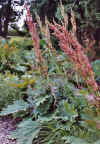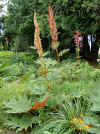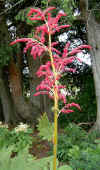MELANOSELINUM (me-LA-no-se-LEE-num)
UMBELLIFERAE. Large monocarpic plants grown for the foliage and large umbels of flowers.
—Melanoselinum decipiens. (25) MELAN-7. Packet: $2.50
'BLACK PARSLEY'. Giant umbels with multiple heads, to almost 3 feet across, and towering to 7 or 8 feet tall. Tender perennial with large divided leaves. Blooms once, then dies. Rare endemic to Madeira. Zone 9. Best in moist to wet sheltered spots. Good in California. Germinates in 4 - 6 weeks. Blooms once then dies, so when this lot is gone, we won't have more seed for 5 years or so.
MENTHA
—Mentha suaveolens. (500) MENT-20. Packet: $2.50
'APPLE MINT'. Fragrant round fuzzy leaves with an apple-like scent. White or pink flowers in sum- mer. Perennial to 1 - 3 feet. SW Europe. Zone 5. Germinates in 2 - 3 weeks.
NEPETA
—Nepeta racemosa. (25) NEPE-22. Packet: $2.50
'CATMINT'. Light blue flowers blooming con- tinuously through spring and summer. Hardy peren- nial to 12". Iran. Zone 3. Germinates in 1 - 3 weeks.
—Nepeta Stewartiana. (25) NEPE-32. Packet: $2.50
'DUO HUA JING JIE'. Lavender-blue flowers in June to September. Hardy perennial to 30", with dark green leaves. China. Zone 6. Germinates in 2 weeks and up.
ORNITHOGALUM (or-ni-tho-GAL-um)
LILIACEAE. Widely distributed Eastern Hemisphere bulbs. The hardy kinds are fairly carefree and good for naturalizing and wild gardens. Tender species good in pots in the greenhouse or in California. As good as tulips and freesias in pots. Good cut flowers.
—Ornithogalum fimbrimarginatum. (25) ORNI-14. Packet: $2.50
Starry white six-petaled lightly fragrant flowers in 18" tall or so, blooming in spring and summer. Bulb with broad flat leaves fringed with white down. South Africa. Zone 9. Germinates in 1 - 2 weeks.
PAPAVER
—Papaver orientale 'Prince of Orange'. (100) PAPA-30PR. Packet: $2.50
Huge bright tangerine flowers up to 5" wide. Hardy perennial to 30". Zone 3.
—paeonyflorum 'Red Peony'. (250) PAPA-32RP. Packet:$2.50
1/4 Ounce: $7.50
Large fully double 4" red flowers. Hardy annual to 3 feet or so.
—Papaver setigerum 'Monet's Poppy'. (500) PAPA-43M. Packet: $2.50
Click for photo »

Single pink-lavender flowers with a darker blotch. Sturdy plants to 4 feet tall, blooming in late June and early July. "I first collected seeds of this plant from the garbage pile at Monet's garden in Giverny, France in the late 1990s."—Aiello. Seed needs cold, prechill or sow in fall or very early spring.
—Papaver setigerum 'Sissinghurst White'. (1000) PAPA-32SW. Packet: $2.50
10 grams: $7.50
50 grams: $30.00 (Yes, it was a typo in the print edition!)
Large purest white single flowers. Originally found at Sissinghurst Castle. About as pure white as can be. Reaches 2 - 3 feet or so.
PASSIFLORA
—Passiflora edulis var. flavicarpa. (25) PASS-12F. Packet: $2.50
1/4 Ounce: $7.50, Ounce: $25.00 BULK OUT OF STOCK - packets are available
'YELLOW GRANADILLA', 'YELLOW PASSIONFRUIT', 'LILIKOI'. Tender, vigorous climber to 30 feet. Flowers 2" across, white with a curly, white banded purple corona, produced all summer. Leaves deeply 3-lobed, glossy. Fruits yellow, 3" long, with orange flesh. Brazil. Grown more for the delicious fruit than the flowers. Good in beverages, sherbet, etc., and is high in vitamin C. Zone 8. Fruits best with two vines. Germinates in 1 - 16 weeks depending on temperature.
PETUNIA (pe-TOON-ya)
SOLANACEAE. The most popular annual bedding plant in the world. Showy and night-fragrant, they bloom all summer and into autumn, and winter bloom in 6" pots can be had from seed sown in July or cuttings taken before frost. Best in full sun and light, well-drained soil. Best sown on the surface, indoors, 10 - 12 weeks before last frost. Germinates in about 2 - 3 weeks at 60°F. Seed half-life 4 - 6 years. The smallest seedlings often produce the best colors. Space 12 - 18" apart. "There is hardly any other flower that will give as much bloom, with as little care, as will the Petunia."—Harry E. Saier.
—Petunia integrifolia. (=violacea) (1000) PET-22. Packet: $2.50
1/4 Ounce: $7.50
Ounce: $14.00
'WILD PETUNIA'. Rosy-purple inch-wide flowers with dark throats. Annual to 8" high and spreading to 18" across. Argentina. Germinates in 1 week and blooms in 90 days. The original petunia, parent with P. axillaris, of modern petunias. This is where it all started! Germinates in 1 - 3 weeks.
PULMONARIA (pul-mo-NAR-ee-a)
BORAGINACEAE. About a dozen spring-flowering Eurasian perennials. Easily grown in part shade.
—Pulmonaria officinalis. (25) PULM-18. Packet: $2.50
'LUNGWORT', 'JERUSALEM COWSLIP'. Funnel-shaped pink 3/4" flowers changing to violet, in forked cymes, March to April. Hardy perennial to 10", with pointed, often white-spotted leaves. Slowly spreads by rhizomes to form nice patches. Europe. Zone 4. "They are among the most elegant ornaments of the flower-garden..."—Loudon, 1829. The young leaves have been eaten in salads or as pot-herbs, and have been used for lung complaints. Seed needs cold treatment or GA-3 to germinate in 1 month.
RESEDA (re-ZEE-da)
RESEDACEAE. Mediterranean herbs grown for ornament, scent, and dye. Sow where they are to grow.
—Reseda odorata. (1000) RESE-18. Packet: $2.50
Ounce: $7.50
1/4 Pound: $15.00
'COMMON MIGNONETTE'. Very sweet scented yellow-white flowers in dense spikes to about 16". Hardy annual with 3" leaves. North Africa. Germinates in 1 - 6 weeks.
RHEUM (REE-um)
—Rheum palmatum var. atrosanguineum. (10) RHEM-20S. Packet: $4.00 OUT OF STOCK
Click for photo »





Leaves unfold deep purple, and keep a nice dark purple on the undersides—attractive when a breeze turns them up to view. Huge scalloped leaves, and red flower-spikes. Select the darkest seedlings. Germinates in 1 - 3 weeks.
RHUS (RUS)
ANACARDIACEAE. 'SUMAC'. Widely distributed and easily grown shrubs, trees and woody vines with small flowers and attractive, often pinnate foliage, often brilliant in fall, and many with colorful fruit. Thrives in any garden soil. Good wildlife habitat and erosion control. Seed of most have hard seed-coats and nicking or hot water treatment helps, followed by cold treatment for some. Seed long lived.
—Rhus typhina. (75) RHUS-38. Packet: $2.50
'STAGHORN' or 'VELVET SUMAC'. Handsome pinnate foliage turns rich shades of orange, red, yellow and purple in fall. Shrub or tree to 30 feet, with thick velvety branches like stag's antlers. Dense clusters of long-lasting red fuzzy fruits. E. N. America. Berries soaked in water for 'lemonade', young pithy stems made into sugar-maple tapping pipes, and an important tannin source. Germinates in about 2 weeks after nicking.
ROBINIA
—Robinia Pseudoacacia 'Shipmast'. (25) ROBI-16S. Packet: $2.50
1936 USDA Booklet - Shipmast Locust, A Valuable Undescribed Variety of Robinia Pseudoacacia: https://www.jlhudsonseeds.net/shipmastlocustva379rabe.pdf
A fine form that has been selected for a straight tall trunk, cultivated for 300 years. The wood is more rot-resistant than common locust, fence-posts having lasted over 100 years. More resistant to borers, too. Select for straight trunks and smaller side branches. Produces few seeds where it originated on Long Island, but much more planted in the interior.
ROSA
—Rosa glauca. (20) ROSE-54. Packet: $2.50 OUT OF STOCK
Red to pink 1 1/2" single flowers in May and June, followed by red 1/2" hips. Shrub to 6 feet, with red- tinged foliage. Europe. Zone 2.
SALVIA
—Salvia kopetdagensis. (20) SALV-42. Packet: $2.50 OUT OF STOCK
Click for photo »
Long spikes of purple-blue flowers in summer. Hardy perennial to 4 feet. Turkey to Turkmenistan. The essential oil is studied for medicinal use.
—Salvia patens 'Blue Angel'. (10) SALV-63B. Packet: $4.00
'GENTIAN SAGE'. Deep gentian blue 1 - 2" flowers in loose clusters in summer. Perennial to 2 feet, with downy foliage. Mexico. Zone 7. Germinates in 1 - 2 weeks.
—Salvia recognita. (10) SALV-68. Packet: $4.00
Rosy white 3/4" flowers with red-marked lip, in July and August. Hardy perennial to 3 feet, with large grey-green divided leaves. Turkey. Zone 5. Dormant seed, try cold or GA-3.
—Salvia ringens. (10) SALV-72. Packet: $4.00
Blue-lilac 1 3/4" flowers in summer. Hardy perennial to 2 feet, with pinnate foliage. Balkans. Zone6. Germinates in 1 - 3 weeks warm.
SIDERITIS
—Sideritis hyssopifolia. (20) SIDE-36. Packet: $2.50
'SPANISH MOUNTAIN TEA'. Light yellow flowers in dense spikes in summer. Perennial shrub- let to 16", with aromatic leaves used as tea. Southern Europe. Zone 6. Germinates in 1 - 3 weeks.
—Sideritis scardica. (20) SIDE-72. Packet: $2.50
S. scardica cognitive effects: https://pmc.ncbi.nlm.nih.gov/articles/PMC6116054/
Overview of medicinal properties: https://www.sciencedirect.com/science/article/abs/pii/S0378874114000695
'OLYMPUS TEA.' Yellow flowers in large spikes. Perennial to 16", with very aromatic woolly foliage used as tea. Greece. Zone 6. Long used as a wild, pleasant-tasting tea, it has been demonstrated to increase cerebral blood flow, oxygenation, and cognitive performance, reducing anxiety, and lung problems. Decreases amyloid in worm models. Germinates in 1 - 2 weeks warm.
SELENE
—Silene Zawadski. (50) SILE-124. Packet: $2.50
White flowers in summer, held above a mound of glossy green foliage. Hardy perennial to one foot. From the Carpathian Mountains. Zone 4.
SILPHIUM (SIL-fee-um)
COMPOSITAE. Tall perennials grown for their large, sunflower-like blooms. Long lived and good in most soils, especially heavy ones. Full sun and easily grown. Stately plants for the back border or prairie and wild gardens.
—Silphium laciniatum. (25) SILP-15. Packet: $2.50
'COMPASS PLANT'. Large yellow sunflower-like blooms in tall spikes. Hardy perennial to 6 feet, with large, striking bipinnately divided leaves, which tend to align themselves north and south. Plains States. Long-lived perennial valued in prairie gardens. Bird love the seeds and it exudes a gum which has been chewed. Give 8 weeks cold or GA-3 to germinate in 2 - 4 weeks. Easy from seed.
—Silphium perfoliatum. (25) SILP-19. Packet: $2.50
'CUP PLANT'. Large yellow 3" wide daisies in clusters from July to September. Hardy perennial to 8 feet, with large, foot-long leaves forming a cup around the stem. South Dakota to Mississippi. Zone 3. Good to naturalize in rich moist soil, sun or part shade. The thick rootstock is medicinal, considered to be a general restorative. Germinates in 1 - 4 weeks warm, often improved by a prechill or GA-3.
SIUM (SYE-um or SEE-um)
UMBELLIFERAE. Aromatic perennials with divided leaves and small white flowers. They do best in rich moist soil, and are grown from seed sown in fall or spring, or by division of the root. Various parts of several species are eaten. Seed viable 3 years.
—Sium Sisarum. (100) SIUM-22. Packet: $2.50
'SKIRRET'. Hardy perennial to 3 feet. The sweet aromatic clustered roots are esteemed as a vegetable. They are eaten raw in salads or in soups and stews. "The sweetest, whitest, and most pleasant of roots."—Worlidge, 1682. Best in a light rich soil. Zone 4. The quality of roots is easily improved by selection. Germinates in 2 - 6 weeks.
SOPHORA
—Sophora japonica.(25) SOPH-3. Packet: $2.50
'JAPANESE PAGODA TREE'. Fragrant creamy white 1/2" flowers in clusters up to 10" long, in late summer. Deciduous tree to 80 feet. China and Korea. Zone4. Pods and flowers produce a yellow dye. Used in traditional Chinese medicine. Germinates in 2 - 3 weeks warm.
TEUCRIUM
—Teucrium Polium.(50)TEUC-64. Packet: $2.50
'GOLDEN GERMANDER'. White to yellow flowers in summer. Low mounding shrublet to 6". Mediterranean. Zone 6. Germinates in 2 weeks and up.
THYMUS
—Thymus fragrantissimus. (100) THYM-9. Packet: $2.50
'ORANGE-SCENTED THYME'. Pink flowers in summer. Low hardy perennial to 10", with a nice orange scent. Zone 6. Germinates in 1 - 2 weeks.
TROPAEOLUM
—Tropaeolum majus 'Black Velvet'. (25) TROP-5BV. Packet: $2.50
50 grams: $12.00
Deep velvety dark maroon flowers with golden throats. Low compact plants.
VERNONIA (ver-NO-nee-a)
COMPOSITAE. 'IRONWEED'. A large genus of 500 - 1000 species of perennials, shrubs, and trees with showy flowers in autumn. Easily grown in the border or wild garden in any good soil. Easy from seed.
—Vernonia fasciculata. (300) VERN-9. Packet: $2.50
`PRAIRIE IRONWEED'. Intense purple flowers in fiat clusters in summer. Hardy perennial to 6 feet, with narrow, deep green leaves. Plains states. Zone 3. Attracts butterflies. Give 4 - 8 weeks prechill.
ZINNIA
—Zinnia elegans 'Isabellina'. (200) Packet: $2.00
Ounce: $6.00
1/4 Pound: $10.00
Soft creamy yellow single and semi-double 4 - 5" flowers on long stems. An old heirloom variety.
ZIZYPHUS (ZI-zi-fus)
RHAMNACEAE. Warm-region deciduous or evergreen trees and shrubs grown for the edible fruits. Seed germinates best if soaked 2 days or given cold. Either 3 months warm, then 3 months cold, or just 3 months cold has worked. Or, the stones can be cracked open and the seeds removed and germinated. Tropical kinds sometimes germinate readily.
—Zizyphus Jujuba. (10) ZIZI-1. Packet: $3.00
'JUJUBE', 'CHINESE DATE', 'DA-ZAO'. Egg-shaped reddish brown 1 - 2" fruits have a sweet, apple-like flavor eaten fresh, or if dried, they become date-like. Deciduous gnarled tree to 20 - 50 feet, with somewhat pendulous branches. Ovate 1 - 2" leaves, and small, yellowish flowers in May and June. SE Europe to China. Hardy to Zone 5 with protection. Can bear in 3 years from seed. Good in deserts. Deep rooted, stands drought and alkaline and saline soils. Used in Chinese and Ayurvedic medicine. Either soak 2 - 4 days then give 1 - 6 weeks prechill, or crack out of shell (difficult and damages many of the seed), then germinate at warm temperatures, and KNO3 helps.